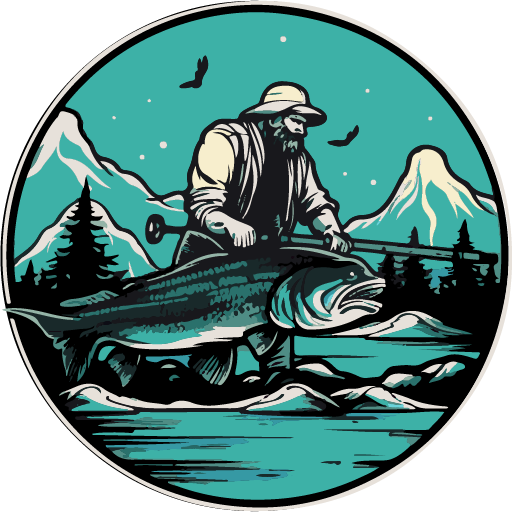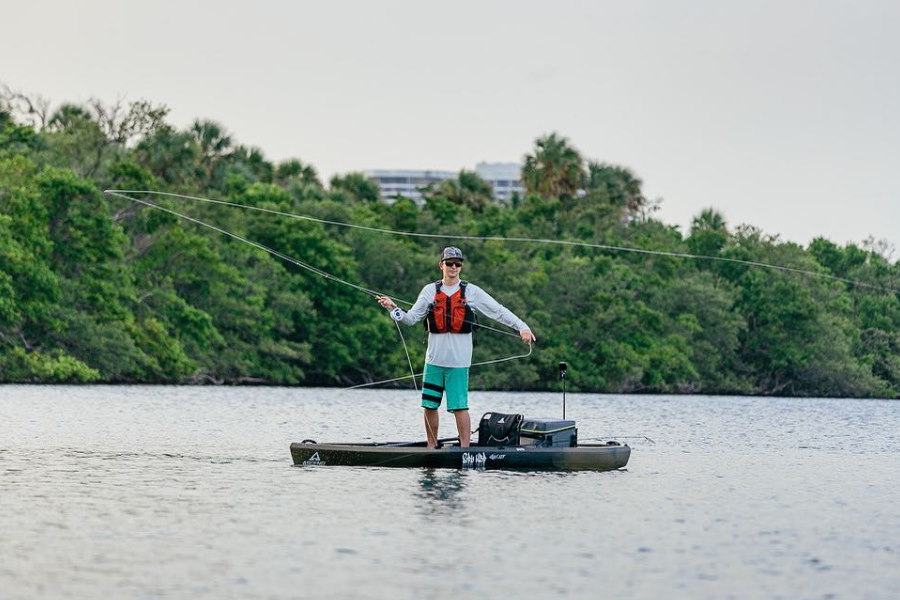Tips for Fly Fishing on a Kayak
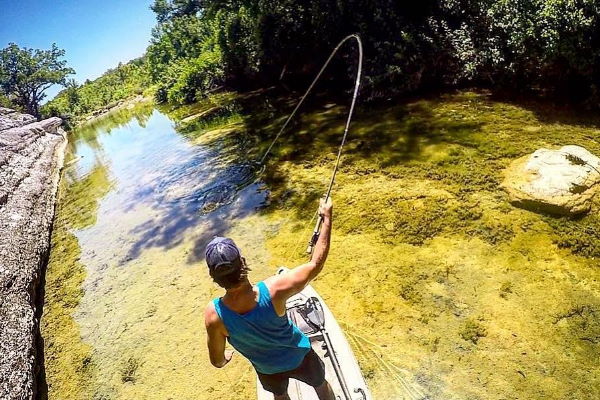
If you’re looking to try something different while fly fishing, why not explore the option of kayak fishing? Kayaks offer a unique way to fish that can be quite enjoyable and exciting.
There’s something special about the freedom gained from maneuvering around quiet waters with an easy-to-use vessel.
With the vast array of open spaces available for exploration via kayaking, this outdoor activity offers unparalleled views and reels in with some fantastic catches. There’s no wonder it has been gaining popularity among enthusiastic fishers!
In this blog post, we have outlined important tips that will help any novice become an expert at fly fishing on a kayak.
What is Fly Fishing?
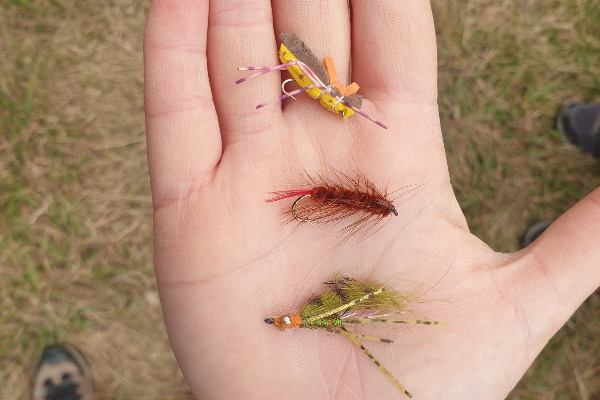
Fly fishing is a type of angling that uses an artificial fly to catch fish. The fly is tied with feathers and other natural materials to resemble aquatic insects, baitfish, or other food sources that the target species would typically feed on.
The goal of fly fishing is to cast the specialized lure at a targeted area to attract fish. Typically, this requires more skill and technique than traditional spin-fishing methods.
The fisherman casts the line out into the water and waits for a strike. When it happens, they must set the hook swiftly to catch their target fish!
What are the Benefits of Fly Fishing on a Kayak?
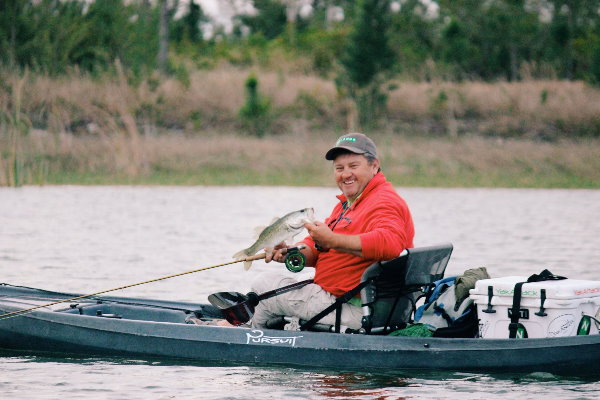
Kayak fishing offers a unique experience that traditional fishing can’t provide, as they offer a combination of stability and maneuverability in tight spaces. With a kayak, you can navigate into tight spots that may be difficult to access by foot or via larger vessels like boats or canoes. You also have more freedom when it comes to exploring different areas and conditions.
It allows anglers to get closer to the water, giving them a better view of what lies below. From the seat in the kayak, you get a physical connection with the water and its inhabitants that simply isn’t possible from land.
Also, kayaks provide a great way to get close to the fish without spooking them. This allows fishers to cast from incredibly short distances, making it easier to catch more fish.
Plus, it’s also an eco-friendly way to explore remote waters!
They are also lightweight and easy to transport, so you can quickly get to your desired fishing spot without much effort.
Finally, kayaks are very inexpensive compared to other types of vessels, making it easier to invest in all the necessary fly fishing gear. You’ll save money on fuel costs too since most kayaks are human-powered. Kayaks also require little maintenance and storage space when compared with boats, making them an affordable option for all budgets.
What Type of Fish Do You Catch Fly Fishing?
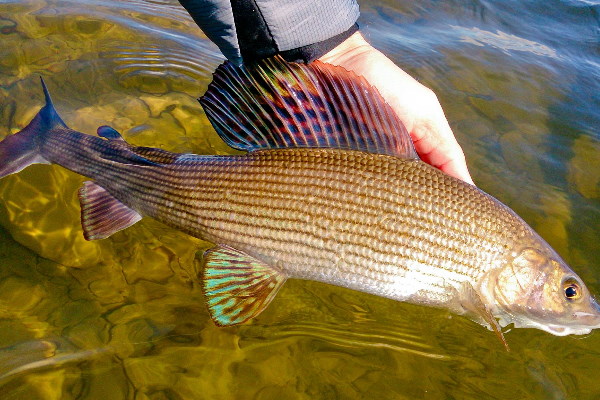
Fly fishing can be used to catch almost any species of fish. However, some fish are more suited for this type of angling than others. The most common types of fish caught with fly fishing include trout, grayling, and salmon.
These predatory gamefish have an active feeding habit that makes them perfect targets for the fly fisher. They often come close to the surface in search of prey, making them easier to target with a well-placed cast.
Plus, these fish are highly sought after by many anglers due to their exciting fighting ability when hooked!
However, species such as pike, bass, carp, and panfish can be caught with fly-fishing techniques – even extending into marine habitats filled with snook, redfish, tarpon, bonefish, or striped bass; no species is left unturned by this joyful art form!
Tip for Fly Fishing on a Kayak
1. Choose a Fly Fishing Friendly Kayak
When you go for a kayak fishing trip, you must choose a kayak that is well suited for the purpose.
When it comes to fly fishing, kayaks need extra consideration due to the active nature of casting a rod. Some kayaks are designed to give you maximum stability, which is great when it comes to fly fishing on a kayak for anglers looking to stand up while casting their line.
The ideal size is 12-14 feet long and at least 30 inches wide for maximum stability while standing up. Hull shape also plays an important role in stand-up stability – flat or pontoon-shaped hulls work best when searching for that perfect catch!
Fear to stand up in your kayak? Don’t worry, a simple 3-foot strap, secured near the front of the seat can provide beneficial assistance. By using this helpful tool you’ll easily move from sitting down to confidently standing up and conquering any watersport challenge!
2. Get a Fish Finder
Fish finders are an incredibly helpful tool for kayak fly fishing. Not only can they help you track schools of fish, but they also provide information such as water temperature and depth.
This data is invaluable when it comes to planning a successful fishing trip. Having a good understanding of the conditions will help you position your kayak in the right spot and give you a chance of catching bigger and better fish!
3. Clear Your Deck of All Line-Catching Snags
When you cast from a kayak, ensuring your line doesn’t get tangled in any debris is essential. Don’t let line-catching snags get in the way of your kayak fishing experience! When shopping for a new model, opt for one with minimal protrusions and doodads on or around the deck area. If you need to bring any tools like nippers or hemostats with you while fly fishing from a kayak, ensure they’re safely secured to either your Personal Floatation Device (PDF) or chest pack so that an accidental sweep doesn’t send them overboard. By organizing gear smartly behind the seat – such as storing items away in below-deck hatches – fishermen can clear their decks of potential line catchers before hitting the water.
Anything that your line could potentially get caught up in should be removed or stowed away securely. These small but essential steps will ensure that you have a successful fly-fishing experience!
4. Look for Fly-Rod Specific Rod Holders
Fly fishing isn’t as straightforward when it comes to kayaks. Most standard models don’t have the right holders, making storage of rods an arduous task, lacking the necessary rod holders for backcasting or spinning rods. To make life easier on your next expedition and ensure that storing your equipment isn’t too much of a challenge, invest in a specialized holder specifically made for fly rodding – they’ll get you hooked up! Investing in a good quality rod holder specifically designed for fly rods will help provide the extra stability and security needed.
You can also make yourself a rod holder. Simply purchase PVC pipe that fits perfectly into flush mounts and mark the desired height, cutting off one inch from this point to create space for the reel. Finish it up by lining your creation with padding material so you can comfortably enjoy hands-free angling!
5. Learn How to Handle Rock Broaching
Taking on obstacles in the water is a daunting task, and it’s important to approach them correctly. In rough waters with a rock broach, rather than leaning away from it – which could cause your boat to flip over as you’re pushed up onto its lower edge by the current. In fact, by leaning into the rock with your paddle or foot for leverage rather than away from it, you may find yourself safely and securely around the obstacle before you know it. This technique is known as ‘rock broaching’, and not only does this work on boulders – any water hazard that requires quick action should be met with an assertive attitude to keep yours and those nearby-safe!
6. Get an anchor
Kayaks offer an amazing way to explore waters inaccessible by larger boats, but their small size can make them vulnerable to wind and water currents. By adding a skeg to the stern, you can resist some drift caused by wind or strong currents; however, an anchor is essential for completely controlling your craft’s position so you don’t miss out on any of that adventure!
An anchor can be a great asset when paddling your kayak offshore, allowing you to stay in position and cast for fish without worrying about drifting. With plenty of off-the-shelf options or DIY solutions available, it’s easy to find the perfect anchoring system for your vessel; then simply learn how best to use it before heading out! When fishing in an area with strong currents or winds, paddling into a likely spot and setting up camp is key – this way you’ll have more time casting rather than repositioning yourself.
Investing in an anchor trolley system and adjustable anchors will help make life easier – when it comes to changing direction or moving further into deeper waters, simply move the trolley along the length of your kayak and adjust the line accordingly!
This setup also allows you to easily release your anchor without any hassle. After all, there’s nothing worse than constantly struggling with tangled lines while fishing!
7. Position Your Kayak carefully
Whether you’re drift fishing or indicator fishing, proper kayak positioning is crucial for a successful angling experience. Experienced fishermen recommend orienting the bow or stern of the vessel into the current to slow down your rate of drift while maintaining control with one hand on the paddle. To achieve an ideal 90-degree angle between your line concerning where it meets the boat, utilize both hands—one holding onto either a fly rod positioned perpendicularly from your craft as well as directly manipulating paddle use at all times when necessary. Moreover, adjusting depth through controlling variables such as an added weight indicator fly can provide various angles for optimal catches!
8. Keep Your Back Casts High
Mastering the technique of casting in a kayak can be an intimidating challenge for novice fly anglers. The proximity to water while seated makes it difficult to keep your backcast high enough and avoid scaring off any fish behind you. However, with focused practice and by tweaking their form, aspiring fishermen can easily conquer this hurdle! It all comes down to directing your cast directly up and back with an abrupt wrist stop at 12 o’clock rather than simply straight-back as normal using an abrupt stop combined with a straight wrist for optimal success – though it might feel awkward initially, consistency will help make adjustments second nature over time.
9. Improve Your Shooting Line to Achieve Distance and Limit False Casts
If you’re looking to cast more precisely and further with fewer false casts, mastering line shooting skills is key – enabling you to maintain tight, short backcasts without having a full belly loop in each cast. This approach will help prevent your backcasts from dragging across the water surface – an issue that’s especially prominent when fishing smaller creek channels or other confined spaces. Improve those skills today for greater success tomorrow!
For those looking to significantly improve their fly-fishing distance, mastering the art of line shooting is key. Bringing your rod tip to a defined stop at the end of your forward cast and letting loose with a non-rod hand as soon as you feel that loop form – essentially allowing for extra momentum generated during the casting stroke itself – will ensure accuracy without requiring numerous false casts or a drawn out series. With practice comes perfection, so let’s get started!
Increase your fishing reach by adding a double haul to your casting stroke and you could soon find yourself achieving the same distance with fewer false casts. Whether standing or in a kayak, this technique can help you keep more lines off the water while still getting maximum performance from every cast.
10. Work The River With A Strike Indicator
Kayak anglers possess a distinct advantage with indicator fishing; their tactics remain consistent regardless of the location along the river. To ensure success, they must master an essential water-load cast to effectively return their fly upstream and make contact with waiting for fish. By slowly lifting the line while accelerating into an upstream cast in one steady motion, kayakers can maximize every opportunity on rivers across the country.
11. Fight Your Catch on the Reel when Fly Fishing from a Kayak
When you have a big fish on the line, it’s important to fight them from your reel rather than directly off your rod. This is due to the limited space available in most kayaks – when your catch becomes too active and you need to take control of the situation quickly, having that extra few inches of line between the rod tip and reel can provide much-needed leverage.
When you’ve hooked into a fish, it’s time to adjust your approach – and line tangles are something to watch out for when fighting in a kayak. To prevent break-offs, reel in as quickly as possible or simply hold onto the rod if large species make hard runs that exhaust them over time!
To do this effectively, start by winding up any slack on the reel before setting the hook firmly into either side with your index finger and thumb. It’s also important to keep palms facing up to maintain maximum grip strength while cranking away at those handles. With practice comes perfection, so get out there and give it a go!
12. Paddle length
For the optimal kayaking experience, selecting an appropriate paddle is essential. The right one should strike a balance between reaching the water efficiently and being compact enough to carry without bulkiness. When deciding on your ideal paddle, consider its style about both the width of your vessel and your height – for beginning paddlers it’s recommended that they find something around 8’2″.
13. Wear Proper Clothing for Fly Fishing from a Kayak
To make sure your adventure goes smoothly and safely, it’s important to dress for what Mother Nature might throw at you – whether it’s intense sunshine or a sudden rain shower! Bring sunglasses, hats, and lightweight long-sleeved clothing when kayaking on sunny days; gloves, neck gaiters, and shell pants will provide extra protection from UV rays.
And don’t forget sunscreen – plus plenty of water! In places where temperatures are colder, it may even be necessary to invest in wetsuits that will keep you warm while giving an additional layer of protection combined with layered garments such as jackets built specifically for kayaking trips. They’re affordable too so there are no excuses not to be prepared! Wearing one with a shell jacket allows maximum warmth but minimal restriction as well as safety out on the waters.
It is also important to remember safety first! Ensure visibility by wearing bright colors or reflective accents during low-light conditions, plus bring along sunscreen and insect repellent that won’t wash off easily in case of rain or splashing. Finally, never forget a personal flotation device – even for experienced kayakers.
14. Start Slow
Begin your kayaking adventures on calm waters, such as lakes and ponds. Take time to get used to the setup of your rig and learn how it navigates different aquatic terrains. As you gain control over the vessel, have fun collecting catches in these serene areas before venturing into more adventurous fishing grounds. Enjoy a newfound sense of freedom with every paddle stroke!
15. Learn to Study the Weather Patterns before Fly Fishing in a Kayak
Kayaks, lightweight vessels in comparison to others, can easily be taken off course by the force of winds or currents. Knowing how to read weather patterns and predict upcoming changes is essential for safe kayaking – if you find yourself presented with gentle conditions then take advantage; paddle towards an area out of reach from strong gusts and drop your anchor before casting your line!
However, when faced with stronger forces it’s important not to forget that these could quickly erode any progress made leaving you vulnerable.
How to Keep Safe When Fly Fishing on a Kayak?
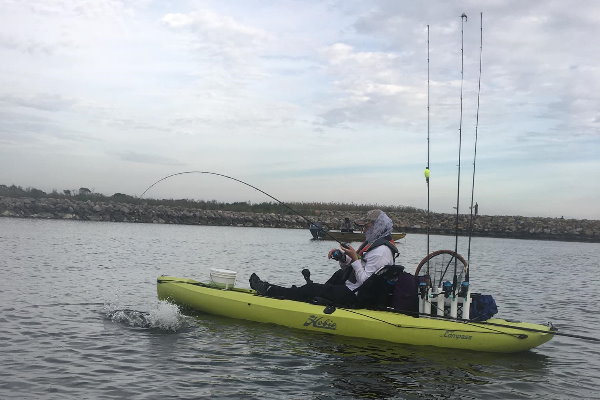
When fly fishing on a kayak, safety should always be your primary concern.
Wear bright colors or reflective accents for low-light conditions, and always wear a personal flotation device in case of an emergency.
Make sure your boat is equipped with the proper safety equipment such as lights and distress signals.
Check the weather forecast before heading out so you can prepare for any bad conditions that may arise. Before casting your line, it’s best to drop anchor in an area away from strong gusts or current forces to ensure maximum safety while also allowing you to cast with ease.
It’s also essential to have a partner with you in case of an emergency, as well as basic knowledge about navigating rapids or strong currents.
Bring along plenty of drinking water and insect repellent that won’t wash off easily so that you can remain hydrated and protected throughout your trip!
Finally, it’s important to take regular breaks throughout the day to rest and enjoy the scenery – this will help ensure that you stay alert and prepared for any unexpected circumstances that may occur.
FAQs
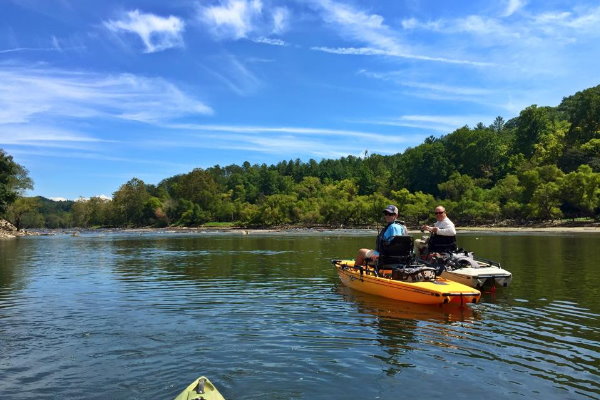
Can I fly fish from a kayak?
Yes, you can fly fish from a kayak! Kayaks provide a great platform for fly fishing as they allow anglers to access remote areas and make stealthy approaches to their target species.
Is it hard to fly fish from a kayak?
Fly fishing from a kayak comes with its own unique set of challenges; however, with practice and experience, you can become an expert kayak angler. It is important to remember that fly fishing from a kayak requires skill and knowledge of the water conditions to stay safe.
Investing in the right type can also make a difference. For an enhanced experience and easier access to casting, anglers should consider getting a sit-on-top kayak – it just may be their new favorite way to fish!
Are fish finders worth it on a kayak?
Yes, fish finders can be worth it on a kayak! They allow you to pinpoint the exact location of fish in the water and even provide information about what type of fish might be present. This makes it much easier for anglers to locate and catch their desired target.
Fish finders also help identify any obstacles or hazards that may be lurking beneath the surface, increasing safety and allowing for more efficient navigation around these areas. Fishfinders are an invaluable tool – especially when fly fishing from a kayak!
Is there a risk of tipping over while fly fishing from a kayak?
The risk of tipping over while fly fishing on a kayak is always present; however, there are measures you can take to minimize this risk. Keeping your weight balanced in the kayak, being aware of your surroundings, and understanding the power of winds and currents can all help reduce the chances of tipping over.
It is also important to be prepared for any situation by having a PFD (Personal Flotation Device) on hand or wearing one at all times. Practicing good safety protocols is essential when fly fishing from a kayak – because even the best paddlers can fall prey to unexpected conditions!
Why is fly fishing so hard?
Fly fishing can be challenging due to its technical nature. While spin or bait fishing may involve a simple ‘cast and release’, fly fishing requires more finesse, as even the slightest movement of wrist and arm can impact the trajectory of your line.
Casting with flies involves using carefully generated movements to achieve maximum momentum so that you can deliver the lure right where it should go – no easy feat!
It requires practice, patience, and a good understanding of the water conditions to effectively cast and present your line into the right areas.
Additionally, anglers must have an understanding of aquatic insects and what type of flies they are likely to attract – this knowledge is essential for successful fly fishing trips!
Finally, mastering the technique and timing of casting also takes time and dedication to perfect your craft. With all that considered, it’s no wonder why experienced fishermen consider fly fishing an art form!
What time of year is fly fishing best?
Fly fishing is best during the warmer months of summer and early fall when water temperatures are higher and aquatic insects are more active. It’s important to note that peak fishing times may vary depending on species and location, so anglers should always do their research beforehand.
Additionally, windy conditions can often be beneficial – as they help disperse flies in the water column, creating increased opportunities for strikes!
Fly fishing season peaks between April and October. Though, for fly fishermen willing to brave the cold weather, it is technically a year-round sport. Additionally, with an abundance of warm weather destinations, fly fishing can be enjoyed all year long.
What size fly is best for trout?
The size of the fly that is best for trout will vary depending on the season, water conditions, and location. Generally speaking, smaller flies are more effective during the warmer months when aquatic insect activity is at its peak, while larger patterns are more successful in colder waters.
To match the hatch and attract larger more pressured fish in tailwaters consider going smaller on flies – think between 12-16 for drys & 18-22 for nymphs! With a selection of streamers, dries, and nymphs you’ll find yourself with plenty of options to cast out your line.
Trout can also be finicky eaters – meaning they may not always take the same type of fly. Experimenting with different sizes and colors can help you identify what works best in a particular situation.
Additionally, using a variety of techniques such as surface skaters or sinking patterns can give you an edge over your catch! Ultimately, success comes down to understanding the fish’s behavior and selecting the right fly for the job.
How do you cast a fly rod from a kayak?
Casting a fly rod from a kayak can be challenging, but with practice and patience, it can be done. The most important key is to find your balance – make sure you are in control of the boat and not letting the wind or currents take over!
When casting, focus on making small movements with your hand and wrist while keeping your upper body still – this will help generate momentum when releasing the line. Additionally, using shorter casts may help you maintain better accuracy and prevent potential tipping in choppier waters.
Finally, always pay attention to your surroundings and keep an eye out for unexpected obstacles or weather changes. Understanding how to cast from a kayak is essential for successful fly-fishing trips!
Do you use sinkers in fly fishing?
Sinkers are not typically used in fly fishing as they can interfere with the lifelike presentation of the lure. Fly anglers usually use weighted lines instead of sinkers to help get their lures deeper into the water column. However, adding a split shot or pinch on weight to your leader can be beneficial in certain scenarios such as deep pools or faster currents.
Additionally, when fishing for larger predators – such as pike or musky – adding some weight can help get your line down deeper into the water column. There are also many ways to adjust the weight and buoyancy of a fly line to achieve optimal performance – allowing anglers to fish effectively in different depths and current speeds.
Conclusion
Fly fishing on a kayak can be an incredibly rewarding experience. You get to enjoy the scenery of being out on the water while also having the chance to catch some fish. One of the best things about fly fishing on a kayak is that it gives you the ability to get into places that other boats cannot go. This means that you can often find yourself in positions where the fish are biting more frequently.
If you are thinking about giving fly fishing on a kayak a try, we would recommend following these tips: 1) Make sure to pack all of your gear ahead of time so that you know exactly what you need when you arrive at your destination. 2) Always be aware of your surroundings and be sure to take safety precautions when necessary. 3) Have fun and don’t forget to enjoy the experience!
Thanks for reading our article. If you have any questions, leave a comment below. You can see more posts on our website here.
Further reading
Setting up a Kayak for Fishing
